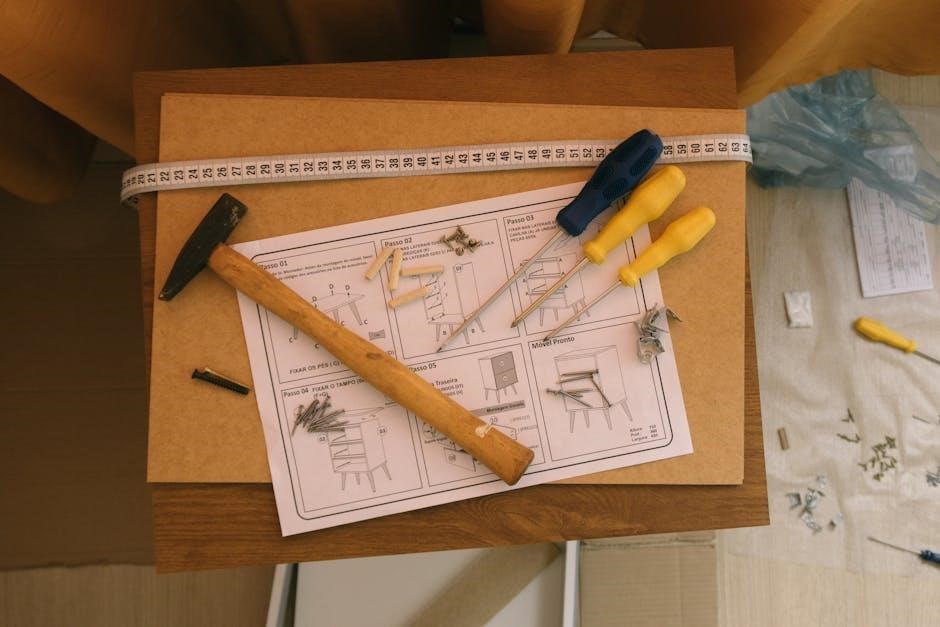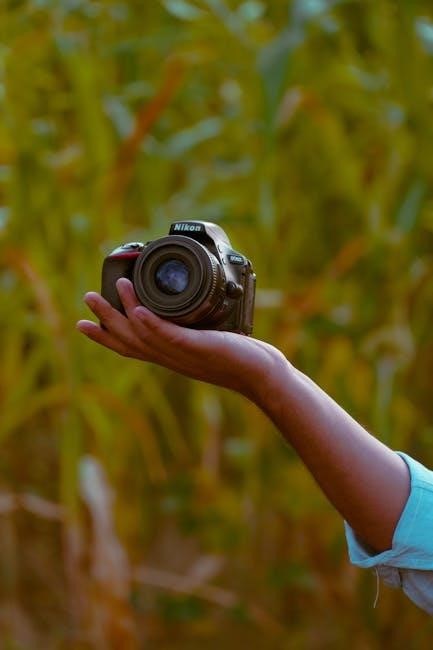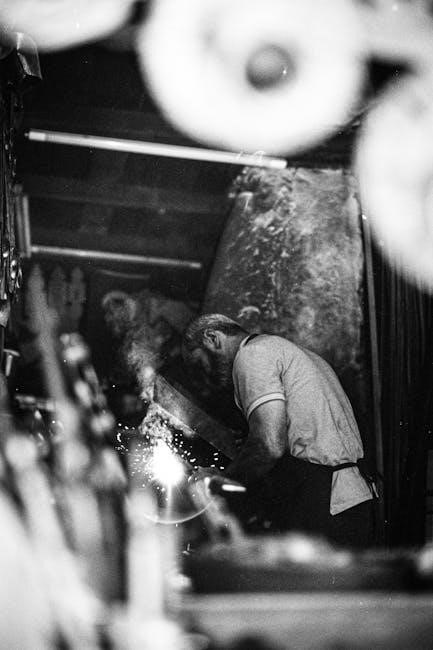The Nikon D700 is a high-performance single-lens reflex digital camera designed for professionals and enthusiasts. Known for its outstanding image quality, durability, and advanced features, it remains a popular choice for photographers seeking precision and control.
1.1 Overview of the Nikon D700
The Nikon D700 is a professional-grade single-lens reflex (SLR) digital camera featuring a full-frame FX-format CMOS sensor with 12.1 megapixels. Designed for photographers seeking high-quality images, it combines advanced autofocus, metering systems, and durability. With its EXPEED image processing engine, the D700 delivers exceptional detail and color accuracy. Its weather-sealed body and robust construction make it ideal for challenging environments, while its intuitive controls cater to both professionals and serious enthusiasts.
1.2 Key Features and Capabilities
The Nikon D700 excels with its 12.1-megapixel FX-format sensor, offering wide dynamic range and low noise performance. It features fast autofocus with 51 AF points and Scene Recognition System for accurate metering. The camera supports ISO 100-6400 sensitivity and U1 and U2 user settings for customization. With a burst rate of 5 fps in FX mode and 8 fps with the MB-D10 grip, it’s ideal for action photography. Additionally, it offers Live View and HDR capabilities, enhancing creative possibilities for photographers.

Initial Setup and Configuration
Begin by unpacking and verifying all components, including the camera body, battery, charger, and manuals. Install the battery and memory cards, then configure basic settings like date, time, and language before first use.
2.1 Unpacking and Inventory Check
Upon unpacking the Nikon D700, verify the inclusion of the camera body, battery, charger, USB cable, and user manual. Memory cards are sold separately. Ensure all items are present and undamaged before proceeding with setup.
2.2 Battery and Memory Card Installation
Insert the EN-EL3e battery into the camera’s battery compartment, located at the base. Use the MH-18a charger to charge the battery before first use. For memory cards, the D700 supports CompactFlash (CF) I and II cards. Open the CF card slot on the camera’s right side, insert the card with the label facing the lens, and gently push until it clicks. Format the memory card via the camera’s menu for optimal performance.
2.3 Basic Camera Settings and Menu Navigation
Start by setting the main switch to turn the camera on. Use the mode dial to select shooting modes like Auto, Manual, or semi-automatic options. Navigate the menu using the multi-selector and OK button. Access key settings like image quality, white balance, and autofocus modes. The info button displays shooting info on the LCD for quick adjustments. Familiarize yourself with the menu system to optimize camera settings for your needs.

Understanding the Camera Controls
The Nikon D700 features an intuitive layout with exterior controls designed for quick access. The mode dial selects shooting modes, while the shutter release button triggers autofocus and capture. Use the multi-selector and control dials to adjust settings like aperture, shutter speed, and ISO. Customize buttons to streamline your workflow for a more personalized shooting experience.
3.1 Exterior Controls and Their Functions
The Nikon D700 features a range of exterior controls designed for intuitive operation. The mode dial on top allows quick selection of shooting modes, while the shutter release button activates autofocus and captures images. The control dials adjust aperture, shutter speed, and ISO, with the multi-selector enabling navigation and focus point selection. Additional buttons like AF-ON and white balance provide direct access to essential functions, streamlining workflow during shoots.
3.2 Customizing Buttons and Dials
The Nikon D700 allows customization of buttons and dials to suit individual shooting styles. The Fn button can be assigned to functions like ISO adjustment or white balance, while the Pv button can be set for metering modes. The control dials can also be customized to adjust aperture, shutter speed, or ISO. This feature enhances shooting efficiency by providing quick access to frequently used settings, making the camera more intuitive and personalized for professional workflows.
Shooting Modes
The Nikon D700 offers multiple shooting modes, including Auto Mode for simplicity, Manual Mode for full control, and Semi-Automatic Modes like Aperture and Shutter Priority for creative flexibility.
4.1 Auto Mode for Beginners
Auto Mode simplifies photography by automatically adjusting settings like shutter speed, aperture, and ISO. Ideal for beginners, it ensures sharp, well-exposed images in various lighting conditions. The camera handles complex adjustments, allowing users to focus on composition; Auto Mode is perfect for learning the basics before exploring manual controls. It provides a stress-free experience, making it easier to capture stunning photos while gaining familiarity with the camera’s capabilities and building confidence in photography skills.
4.2 Manual Mode for Advanced Control
Manual Mode offers full control over exposure settings, allowing photographers to adjust shutter speed, aperture, and ISO to achieve specific artistic effects. This mode is ideal for experienced users seeking precise control. By manually setting each parameter, photographers can customize the look of their images, from freezing fast-moving subjects to creating shallow depth of field. It’s a powerful tool for mastering advanced techniques and unlocking the camera’s full creative potential, ensuring every shot meets the photographer’s vision perfectly.
4.3 Semi-Automatic Modes (Aperture Priority, Shutter Priority)
Aperture Priority (A/Av) and Shutter Priority (S/Tv) modes offer a balance between control and convenience. In Aperture Priority, set the aperture to control depth of field, while the camera adjusts shutter speed. Ideal for portraits or landscapes. In Shutter Priority, set the shutter speed to freeze or blur motion, with the camera adjusting aperture. These modes provide flexibility for creative control without manual adjustments, making them versatile for various shooting scenarios and preferences. They strike a perfect balance for photographers seeking precision without full manual operation.

Autofocus and Metering Modes
The Nikon D700 features advanced autofocus systems for precise subject tracking and metering modes to ensure accurate exposure, enhancing overall image quality and control for photographers.
5.1 Autofocus Modes and Settings
The Nikon D700 offers versatile autofocus modes tailored for diverse shooting scenarios. The AF-S (Single AF) mode is ideal for stationary subjects, while AF-C (Continuous AF) excels in tracking moving subjects. Users can also employ Manual Focus for precise control. Customizing autofocus settings, such as adjusting AF sensitivity and focus tracking, enhances performance. The camera supports advanced focus modes like Dynamic Area AF and 3D Tracking, ensuring sharp focus even in dynamic compositions. Properly configuring these settings optimizes autofocus accuracy and speed for professional-grade results.
5.2 Metering Modes for Accurate Exposure
The Nikon D700 features three metering modes to ensure precise exposure control. The Matrix Metering mode analyzes the entire scene for balanced results. Center-Weighted Metering prioritizes the central area, ideal for portraits. Spot Metering measures a small section, perfect for high-contrast lighting. Each mode can be fine-tuned to match shooting conditions, enabling photographers to achieve accurate exposures with minimal adjustments. Proper use of these modes enhances image quality and captures the desired artistic intent effectively.

Advanced Features
The Nikon D700 offers advanced features like ISO sensitivity up to 6400, White Balance adjustments, and Flash Photography with rear-curtain sync for creative control over lighting and image capture.
6.1 ISO Sensitivity and Noise Reduction
The Nikon D700 excels in low-light conditions with an ISO range of 200-6400, extendable to 25600. Its advanced noise reduction system minimizes grain, ensuring clean images even at high sensitivities. This flexibility allows photographers to capture sharp, detailed shots in various lighting environments without compromising quality. The camera’s noise reduction algorithms are customizable, offering a balance between detail retention and smoothness, making it ideal for both professional and creative applications.
6.2 White Balance and Color Temperature
The Nikon D700 offers precise control over white balance to ensure accurate color representation. With options like Auto, Preset, and Custom settings, photographers can adjust for various lighting conditions. The camera allows manual adjustment of color temperature (2500K-10,000K), enabling fine-tuned results. This feature is particularly useful for capturing natural tones in diverse environments, from daylight to artificial light sources, ensuring consistent and professional-looking images. Custom white balance settings can also be saved for quick access, enhancing workflow efficiency.
6.3 Flash Photography and Sync Modes
The Nikon D700 supports flash photography with its built-in flash and compatibility with external Speedlights. It offers multiple sync modes, including Front-Curtain Sync and Rear-Curtain Sync, allowing photographers to achieve desired lighting effects. Rear-Curtain Sync is ideal for capturing motion trails behind moving subjects. The camera also features wireless flash control, enabling off-camera flash setups without additional accessories. These capabilities enhance versatility in various lighting conditions, ensuring professional-grade results in both studio and outdoor environments. Proper synchronization settings are crucial for optimal flash performance.

Image Management
The Nikon D700 supports JPEG, RAW, and TIFF file formats for versatile image capture. Built-in tools allow for image review, editing, and organization, streamlining workflow. Options for transferring images to external devices ensure efficient management.
7.1 File Formats (JPEG, RAW, TIFF)
The Nikon D700 offers multiple file formats to suit different needs. JPEG is ideal for sharing and reduces file size while maintaining quality. RAW captures maximum data for post-processing flexibility. TIFF provides high-quality uncompressed images. Each format can be selected via the camera’s menu, allowing photographers to choose based on their workflow and requirements. Understanding these formats ensures optimal image capture and editing capabilities. Proper format selection enhances efficiency in managing and processing photographs.
7.2 Image Review and Playback Options
The Nikon D700 allows for convenient image review and playback. Pressing the playback button displays captured images on the LCD screen. Users can zoom in to check focus and details, or scroll through images quickly. The histogram is available to assess exposure. Unwanted images can be deleted directly during playback. Additionally, photos can be rotated for proper orientation. These features make reviewing and managing images straightforward and efficient, enhancing the overall shooting experience. This ensures photographers can quickly evaluate their work in the field.
7.4 Organizing and Transferring Images
Organizing and transferring images on the Nikon D700 is streamlined for efficiency. Users can create folders to categorize photos, making it easier to locate specific images. The camera supports USB transfer to computers for backup and editing. Additionally, images can be transferred wirelessly using optional adapters. The camera also allows for in-camera rating and tagging, helping photographers organize their work during shoots. These features ensure a smooth workflow from capture to post-processing. This capability is essential for managing large collections of photos effectively.

Tips and Tricks
Customize camera buttons for quick access to frequently used settings. Regularly clean the sensor and update firmware for optimal performance. Use high-quality memory cards for reliability. Always carry spare batteries and lenses. Experiment with flash sync modes for creative effects. These tips enhance your shooting experience and camera longevity.
8.1 Optimizing Camera Performance
Regularly clean the sensor and update firmware for optimal functionality. Use high-quality memory cards to ensure fast data writing and reliability; Customize camera buttons to streamline your workflow and improve efficiency. Experiment with shooting modes and settings to match your creative vision. Always test new configurations before critical shoots to avoid unexpected issues. Properly organize files and settings to maintain smooth camera operation over time.
8.2 Troubleshooting Common Issues
Common issues with the Nikon D700 include autofocus malfunctions, error messages, and slow performance. Reset camera settings to default or update firmware to resolve software-related problems. Check battery levels and ensure proper installation of memory cards. For autofocus issues, clean the sensor and lenses, and test with different lenses. Use manual focus mode as a backup. Regularly clean the camera’s electrical contacts to prevent errors. Refer to the manual or online resources for detailed solutions to specific problems.
The Nikon D700 remains a legendary DSLR, offering exceptional performance, durability, and creative control. Its robust build and versatile features ensure it’s a timeless choice for photographers seeking excellence.
9.1 Summary of Key Takeaways
The Nikon D700 is a powerful DSLR that delivers exceptional image quality and performance. Its robust build, intuitive controls, and advanced features make it ideal for professionals and enthusiasts. Key highlights include 12.1MP FX sensor, ISO 100-6400, and 51-point AF system. Mastering modes like Manual and Autofocus enhances creativity and precision. Regular firmware updates and proper maintenance ensure optimal functionality. Exploring its advanced features and customization options can elevate your photography to new heights, making the D700 a timeless tool for capturing stunning images.
9.2 Resources for Further Learning
For deeper mastery, explore the Nikon Manual Viewer 2 app for digital manuals and guides. Thom Hogan’s Complete Guide to the Nikon D700 offers detailed insights and tips. Visit dpreview.com for in-depth reviews and comparisons. Nikon’s official website provides tutorials and firmware updates. Join photography forums and communities for shared experiences and expert advice, ensuring continuous improvement in using your Nikon D700 effectively.

